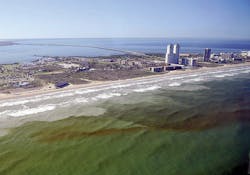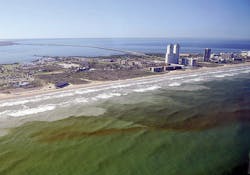Septic Warfare
The Fight for Life, Liberty and the Pursuit of Healthiness
By George Vorsheim
We hold these four truths to be self-evident:
1. If properly designed, constructed and maintained, a septic system can provide long-term, effective treatment of household wastewater.
2. A malfunctioning septic system can contaminate groundwater that might be a source of drinking water.
3. Millions of failing septic systems in the United States are impacting the environmental quality of life for millions of Americans, as well as contributing to algal blooms and red tides that can result in aquatic fish kills.
4. Most septic systems are not properly maintained and/or have reached the end of their useful lives.
Example of red tide off the coast of Texas. Photo: NOAA
So, by now you’re thinking, “Tell me something I don’t know.” The spreading septic threat is no secret anymore. Septic tank proliferation really took off during the post-WWII housing boom and was originally meant as a temporary solution until proper central sewer networks could be installed in America’s blossoming new suburbs. The transition to central sewer did not always happen according to plan, as municipal budgets were pulled and stretched in too many other directions.
The Clean Water Act initiated during the Nixon Administration and the subsequent Construction Grants Program were envisioned to lead the country back to clean water. With the looming sunset of the grant programs in the late 80s and the rise of the State Revolving Fund (SRF) era, smaller communities not big enough to swing costly and complex municipal bonds found a financial instrument that could work for them. However, the EPA “Needs Surveys” always seem to out-need the available funding by huge factors that now total in the hundreds of billions of dollars.
Flash to the present day and we’re hearing more about how Public Private Partnerships (P3s) will provide much-needed financing, primed by funding from the Trump Administration’s proposed “Infrastructure Initiative” package, now stalled in some pretty heavy traffic on the Hill. P3s could indeed provide financing access for many municipal projects, but those smaller communities had better “bundle” themselves together to make a project big enough for the expense of the financial pros structuring the deal. Witness what the Indiana Finance Authority (IFA) proposed in its 2017 “Letter of Interest” to access WIFIA funds in order to expand the reach of its Clean Water and Drinking Water State Revolving Fund programs and fund dozens of additional projects in communities across the state.
And, have no doubt that the sewer Resistance will continue with arguments ranging from:
• My septic tank is healthy and happy.
• Installing sewers will enable sprawl.
• We have no money for this central sewer.
• Get off my property!
Whether it’s lack of funding/financing or short-term, self-serving reasons, the common denominator for achieving septic tank elimination boils down to the people’s will. And that has to be translated into powerful political will to get — and then preserve — clean water for all citizens.
So, consider this a call to arms. It’s time for a nationwide, urban and suburban, ban on septic tanks, which are contributing to groundwater pollution in the U.S. when they fail. It’s been said that if we’re not part of the solution, we’re part of the problem. In coming months, watch this space for more important information regarding how you can be part of the solution and help protect this great nation’s environmental quality of life, liberty, and the pursuit of public health.
Find out how to join in this mission now by contacting the Water and Wastewater Equipment Manufacturers Association (WWEMA) Executive Director Vanessa Leiby at (703) 444-1777 or [email protected]. WW
About the Author: George Vorsheim is director of communications at Environment One Corporation. He is also a member of the Board of Directors of WWEMA, a non-profit trade association founded in 1908. WWEMA’s vision is to be the “voice of water and wastewater technology providers” and its mission is to promote the advancement of technology solutions for clean water that ensures a future sustainable environment and to improve its members’ economic viability. More information about WWEMA can be found at www.wwema.org.
Circle No. 257 on Reader Service Card

